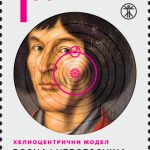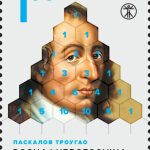Famous persons 2023
Title:Famous persons
Date of Issue: 23.02.2023.
Author: Nebojsa Djumic
Type edition: commemorative
Printing techniques: multicolour offset
Sheet: 10
Paper: muflep 100g
Printing House: Blicdruk, Sarajevo
 Motive: Nikolaus Kopernikus
Motive: Nikolaus Kopernikus
Каталошки број: 927
Perforation: 13 3/4
Face value: 1.95 BAM
Quantity: 13 000
 Motive: Blaze Pascal
Motive: Blaze Pascal
Catalogue no.: 928
Perforation: 13 3/4
Face value: 1.95 BAM
Quantity: 13 000

Nikolaus Kopernikus, astronomer, canonist, jurist, mathematician, physician and economist, is best known in the world for the part "On the Movement of Heavenly Bodies", in which he described the heliocentric vision where the Earth is not any more in the center of the universe, but the Sun, while the Earth and other planets revolve around it in ideal circular paths. Also, it determines the triple movement of the Earth: rotation around its axis, around the Sun and the precession of the Earth's axis, and all of this is done in astronomy as a hobby. In 1616, 76 years after the publication of his famous work, the Church forbids that work, because it contradicts the Bible. The world could legally read "On the Motion of the Heavenly Bodies" only after another 206 years had passed. In the meantime, in 1633, many took advantage of Copernicus' knowledge and pushed science further. The most famous among them is Galileo Galilei, who was condemned by the Church 90 years after Copernicus' death because of the contract of Copernicus' theory of heliocentrism
Блез Паскал био је француски математичар, физичар и филозоф. Отац га је подучавао латински и грчки, а за математику је сматрао да је треба учити са петнаест година, чиме је Блез само још више развио своју радозналост. Већ са шеснаест година, Паскал је издао јединствен примјерак листа са једног од Мерсенових састанака у јуну 1639. године. Садржао је бројеве теорема из пројективне геометрије, укључујући ту и Паскалов мистични шестоугао. Блез је написао свој први рад назван „Есеј о конусним пресјецима“, издат фебруара 1640. године. Исте године Паскал је изумио и први дигитални калкулатор са намјером да помогне свом оцу у прикупљању пореза и такси. Године 1653. пише своје дјело „Теза о аритметичком троуглу“, износећи у њему опис табеларног приказа за биномне коефицијенте који се данас зове Паскалов троугао. Догађаји из 1646. године су били врло значајни за младог Паскала, губитак оца и велики утицај браће који су били у религиозном покрету из Руана, чине Паскала веома религиозним. Након тога настаје Паскалов најпознатији рад из филозофије “Мисли“, а на издању о својим личним мислима везаним за људску патњу, судбину и Бога, којем је приступио касне 1656. године, наставио је да ради током 1657. и 1658. године. Овај рад садржи и Паскалову опкладу као доказ да је вјеровање у Бога разумно само са пратећим аргументима.
Author: Nebojsa Djumic
Publisher: Poste Srpske a.d. Banjaluka



